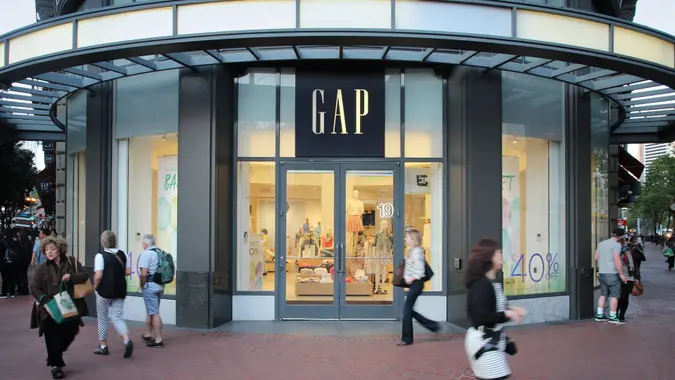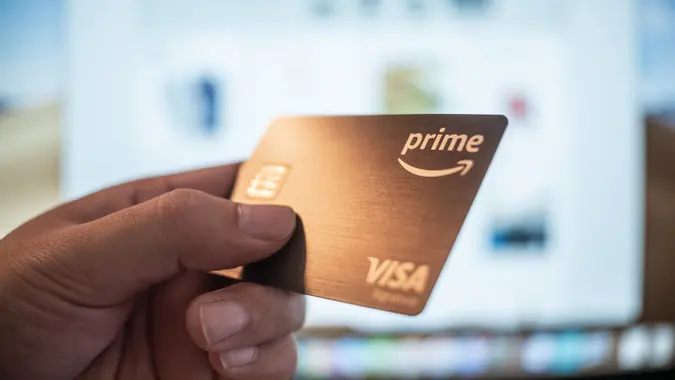5 Ways Credit Cards Make You Spend More

Commitment to Our Readers
GOBankingRates' editorial team is committed to bringing you unbiased reviews and information. We use data-driven methodologies to evaluate financial products and services - our reviews and ratings are not influenced by advertisers. You can read more about our editorial guidelines and our products and services review methodology.

20 Years
Helping You Live Richer

Reviewed
by Experts

Trusted by
Millions of Readers
Ever run wild with a Discover card at the Apple store and then flip out weeks later when the bill comes? You’re not alone. As it turns out, individuals spend much more money when using credit cards as opposed to debit cards or cash. This may not be entirely surprising, but it does make one wonder: what is the psychology in play regarding how and why this happens? Let’s break it down.
Here are five ways credit cards make you spend more money than other payment methods.
Payment-Consumption Disconnect
Steven Kibbel, CFP and senior editor at International Money Transfer explained that there is an emotional pain one feels when paying with cash or debit cards because the deduction is immediate. Psychologists call this the “pain of payment” which can curb spending by reminding you that you are parting with your hard-earned cash.
“Credit cards, however, detach the act of buying from the actual payment, which happens later,” said Kibbel. Your bank balance isn’t even reducing. “This delay numbs the sense of financial loss, making it easier to spend.” The focus becomes the product you’re buying rather than the price you’re paying for it.
Pleasure Centers Activated
Taking the above one step further, “credit cards motivate spending by exploiting reward networks in the brain, which may become sensitized through reinforcement and conditioning processes,” wrote University of Utah professor, Sachin Baker, for about a study he conducted in 2021 with M.I.T. Sloan School Of Management professor, Drazen Prelec. The simple act of swiping a card produces immediate pleasure in the dopaminergic reward center of the brain called the striatum. After a while, credit cards create an anticipation of pleasure in much the same way “part of the brain … is exploited by addictive drugs like cocaine and amphetamines.”
When it comes to spending, credit cards encourage individuals to step on the gas.
Gamification
Because credit cards encourage spending to receive points or cash back, individuals “reduce the consideration of a purchase, but increase the justification of a purchase,” stated Reilly Newman, brand strategist and founder at Motif Brands. This can produce a sense of gamification. “As users enjoy trying to optimize their points and ‘win’ with their credit cards.”
Founder and financial advisor at Campos Wealth Management, Cynthia Campos Delgado, likened this gaming incentive to a form of baiting and warned against falling prey to gimmicks. She explained that, because credit card companies offer higher points and/or lower interest for spending a certain amount of money over a specific time period, consumers find that once they get to the end of the bonus period, they’re deeper in debt with no realistic way to pay it off. “What you think you ended up saving really ended up costing you,” said Delgado.
Convenience Encourages Impulse Spending
“Swiping or tapping a card is effortless, almost mindless,” said Kibbel. “This ease facilitates quick, repeated transactions, like buying an extra coffee or an item at checkout — without the same level of consideration you might give if you were counting out cash.”
Since the time of purchase consideration decreases with the use of a credit card, there’s less room to rationally think about what you’re doing or what the consequences may be. You’re more easily falling victim to temptation. This can be particularly exploitative for those who suffer from poor impulse control.
False Sense of Wealth and Autonomy
“So, you don’t have $5,000 in your account, but the figure is there to spend on your credit card, making you feel wealthy,” said Nicole Issa, a clinical psychologist and founder of the Center for Dynamic and Behavioral Therapy. Illusion is a powerful tool. Sometimes it can override reality. After all, everyone wants to be queen for a day, and credit cards are much more accessible to the average American than thousands of dollars.
Additionally, Newman stated, “Credit card brands have successfully positioned the use of credit cards to represent independence and autonomy.” — Since you can buy what you want when you want it. No asking for handouts or waiting for payday. Yet, it’s this desire for freedom that keeps many enslaved to credit card companies for the long haul.
 Written by
Written by  Edited by
Edited by 

























